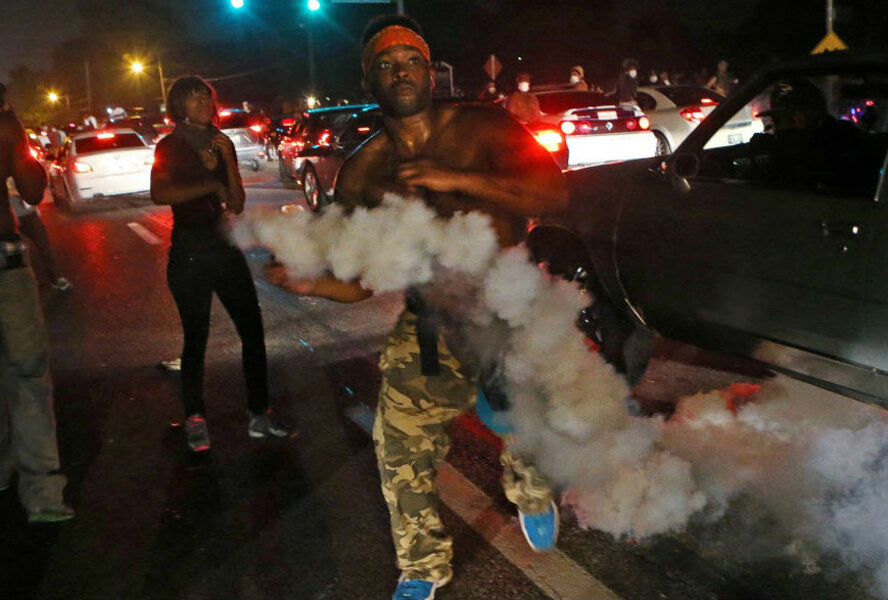Ferguson: Who are the outside agitators entering the fray?
Loading...
Over the past 10 days, the rioting in Ferguson, Mo., has turned from a local protest by a black community against its overwhelmingly white police force to an international symbol of the racial tensions that still plague urban America.
Along the way, outside protesters have begun to flood into the suburb, inciting violence even when community members are promoting peace. While the exact number of “militants” – as the hard-core, Molotov cocktail-throwing outsiders have been called – is unknown, Missouri police officials and politicians have implied that they compose a significant fraction of those looting and battling police.
On Monday, when Missouri Gov. Jay Nixon (D) signed an order deploying the National Guard to Ferguson, he cited “violent criminal acts of an organized and growing number of individuals, many from outside the community and state, who are putting ... residents and businesses ... at risk.”
On Tuesday, after a night in which police reportedly came under “heavy attack” from “coordinated” groups, Missouri State Highway Patrol Capt. Ron Johnson, a black Ferguson native, pledged in an interview with CNN that he would “not ... let criminals that have come out here from across this country or live in this community define this neighborhood.”
US Sen. Claire McCaskill (D) of Missouri said on MSNBC that Ferguson had been “invaded” by agitators from other communities.
While many of these outside protesters have come from other parts of the St. Louis area with deep racial imbalances in local governments and police departments, many have also arrived in buses from places like New York, Chicago, and Detroit. Though county police have not publicly released arrest numbers relating to the riots, a bundle of about 50 arrest reports obtained by a Washington Post reporter included a “large number” with Illinois and Texas addresses.
“It’s like looting tourism,” an officer told the Post. “It’s like they are spending their gas money to come down here and steal.”
While many of these outsiders have come on their own initiative, others are part of larger fringe organizations. None will reveal their names, and many carry guns.
Among the groups active in Ferguson are the Revolutionary Communist Party (RCP) and the Revolution Club of Chicago. The RCP – a small, mysterious, but nationally dispersed Maoist cell led by activist Bob Avakian – has been in the area since at least Wednesday, along with the Revolution Club and the New Black Panthers Party. The New Black Panthers Party has been classified as a hate group by the Southern Poverty Law Center, among other organizations.
“We have a responsibility to be here,” Lou Downey of the Revolution Club told The Kansas City Star. “We are revolutionaries. We’re working to do this in a way that puts an end to the system that for generations has criminalized youth, especially black youth, and rounds them up into prisons.”
That’s not to say that all outside groups involved in the protests are inciting violence. Organizations such as the National Association for the Advancement of Colored People and the Organization for Black Struggle have advocated peace on the streets.
Protesters also say that the most heavily armed groups in Ferguson at the moment are police and the National Guard, which arrived on Monday after rioters fired guns and threw incendiary devices at police. In the past week, local law enforcement – namely the Ferguson Police Department – has come under criticism for employing militarized equipment, including automatic weapons and mine-proof armored vehicles, and wearing military fatigues.
On Monday night, police resorted to tear gas and stun grenades after coming under “heavy gunfire,” according to Captain Johnson.
Police have also been criticized in recent days for heavy-handed treatment of journalists.
Last Wednesday, Ferguson police arrested two reporters, one from The Washington Post and another from The Huffington Post, apparently without strong justification, and they fired tear gas at an Al Jazeera television crew while its members were setting up a video shoot behind a police cordon. On Monday night, county police temporarily detained three more journalists: Getty photographer Scott Olson, Lukas Hermsmeier of the German outlet BILD, and Ryan Devereaux of The Intercept, an organization covering national security issues.
“We are concerned by the detention and harassment of reporters trying to cover the news in Ferguson,” Robert Mahoney, director of the Committee to Protect Journalists, said in a statement Monday. “Journalists have a right to work freely in the streets of any American city, and authorities in Ferguson have a duty to ensure that they can do so there too.”
• This report includes material from Reuters.







